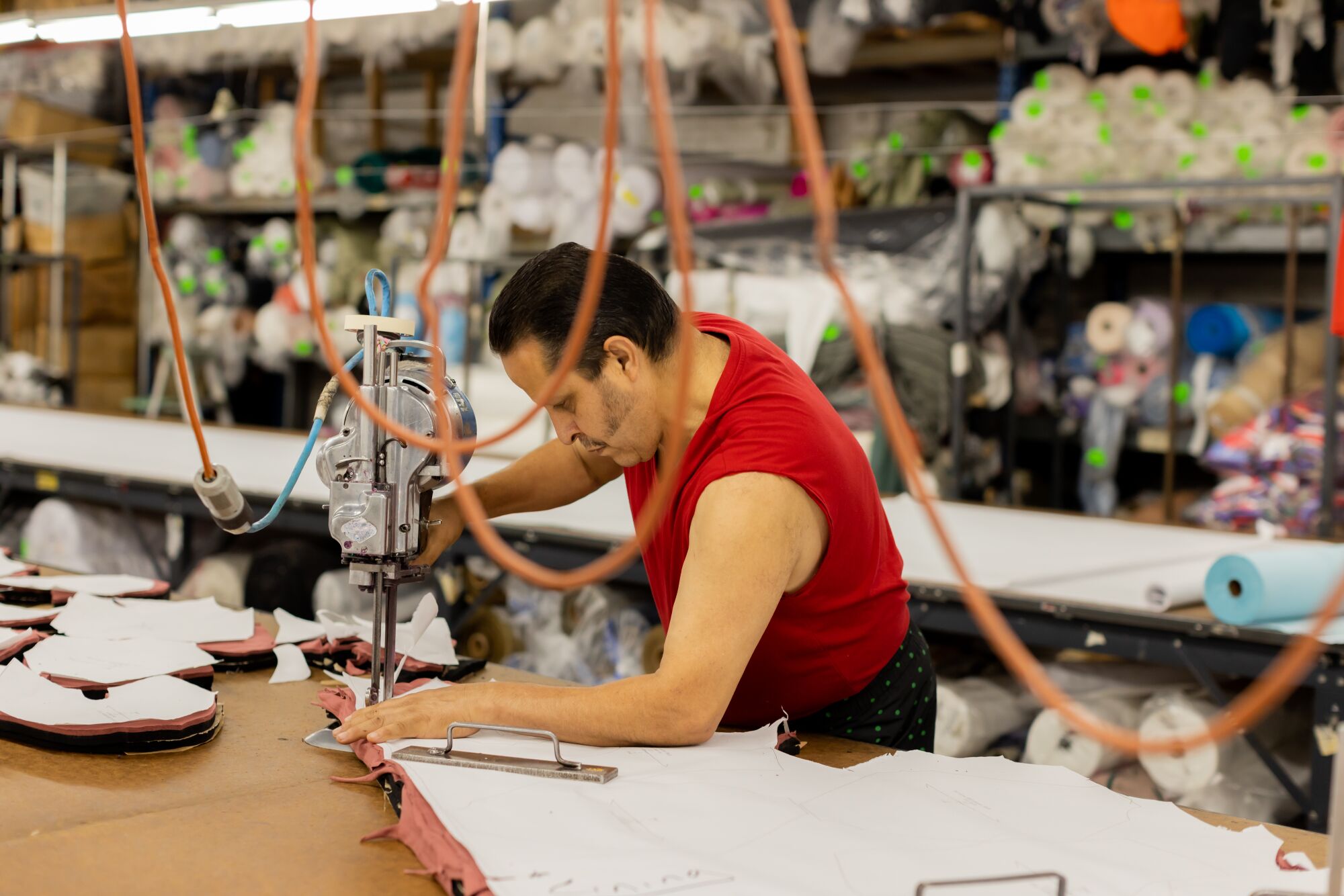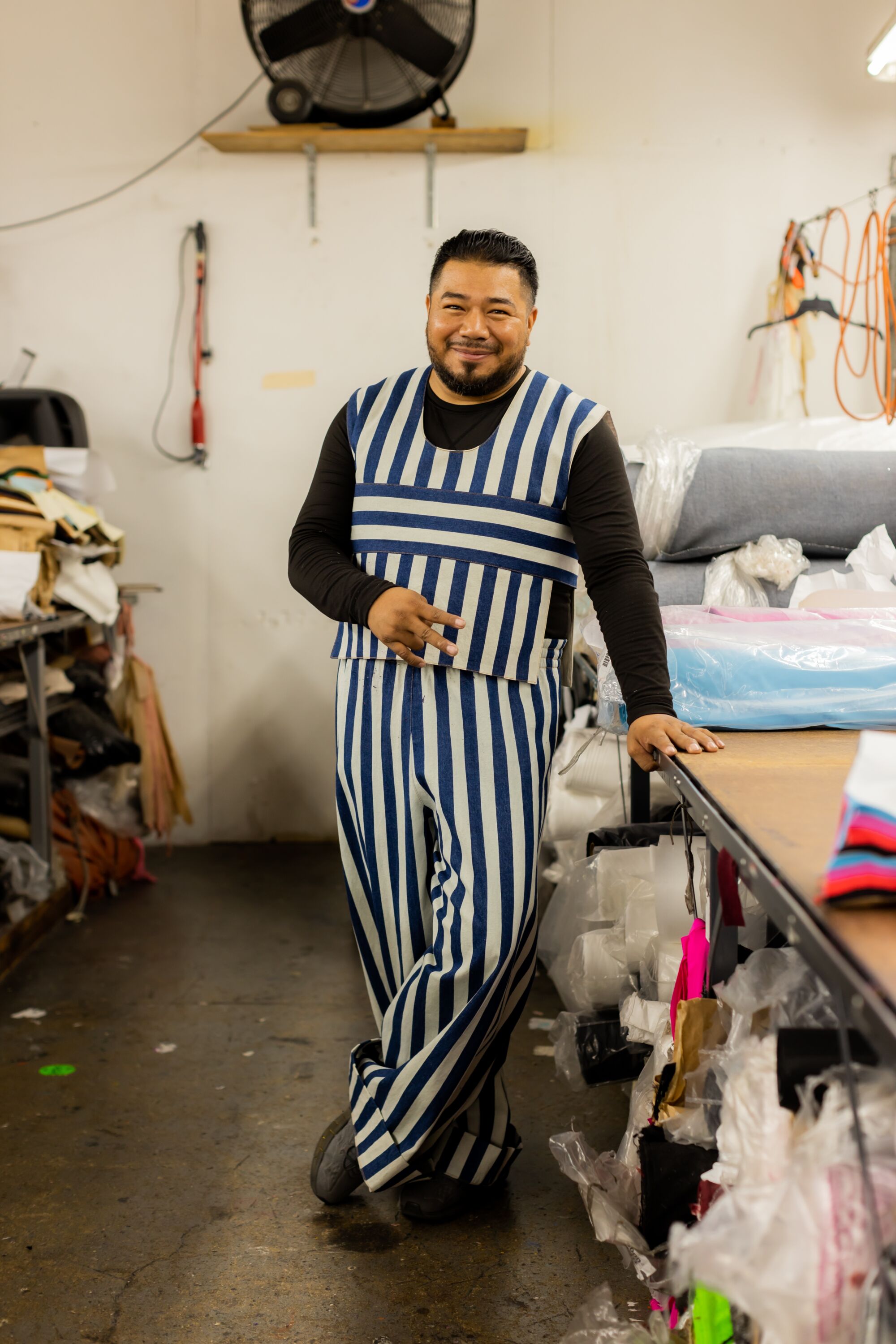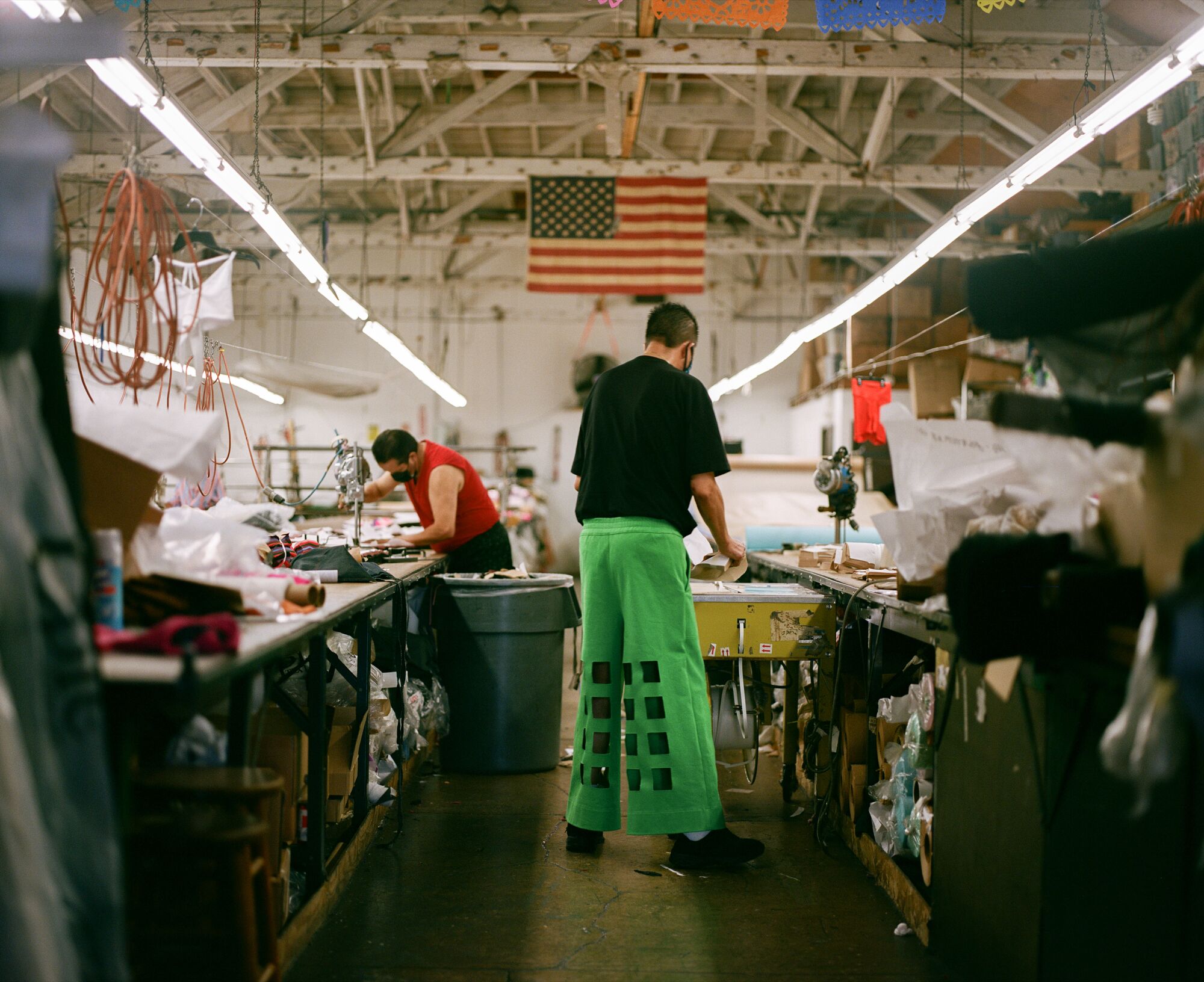Thanks to everyone who ever held a Nancy Stella Soto.

Top row left to right: Don Chuy wears his own shirt and Nancy Stella Soto swirl pants; Lalo wears a custom-made T-shirt of his favorite band, El Recodo, and Nancy Stella Soto grid cut-out pants; Armando. Bottom row left to right: Rolas wears a Nancy Stella Soto leisure uniform and his own undershirts; Carlos wears his own shirt and Nancy Stella Soto shift pants; Nancy wears a Nancy Stella Soto collared shirt and thrifted denim shorts; Lupita wears Nancy Stella Soto hand-stamped dot robe; Ricardo wears his own Club Puebla jersey and Nancy Stella Soto cut-out shorts. Cutting work by Express Cutting Service. Sewing by Santa Rojas.
(June Kim/For The Times)
This story is part of Image issue 13, “Image Makers,” a celebration of the L.A. luminaries redefining the narrative possibilities of fashion. Read the whole issue here.
Nancy Stella Soto doesn’t seem to sweat the organized chaos in front of her. She’s telling me about a recent trip she spent running around in search of a bright orange ditsy print. The kind you might feel like you’ve seen before on Etsy, but one that up close has a more unique feel and texture. In L.A., the country’s fashion manufacturing capital, there’s a place you go if you’re looking for the right fabric: DTLA’s Fashion District. Outside, it’s all Pro Clubs and foot traffic. Inside, there are reams upon reams of linen, cotton, knit, and woven fabrics.
On this particular visit, Soto, 45, says, she was looking through deadstock — fabric sold by jobbers, industry workers who buy and resell left-over textiles usually in limited quantities. Soto’s signature style is defined by these leftover textile materials and other reclaimed trimmings she encounters. Her preferred mode of creativity is stretching new fabrics to their artistic limits and finding alternative uses for existing materials, such as a pile of cut fabric or an old pattern. “I had bags full of scraps — tiny, 6-inch in length and very narrow pleated scraps from a previous collection — but I didn’t want to toss them because they’re, they’re of value to me,” she tells me.
She’s partial to self-imposed limitations, like strategically placing a rectangle in an otherwise ordinary pencil dress. Soto is the type of artist who thrives on establishing parameters and figuring out how to work within them. Other times, she’s interested in seeing how far an idea can go. “Sometimes a previous collection will inspire the next collection,” she says. “Let’s say there’s a certain detail that I really like — I want to push that further and explore it a little.”

Soto’s signature style is defined by these leftover textile materials and other reclaimed trimmings she encounters.
(June Kim/For The Times)
No matter the boundary or criterion, a Nancy Stella Soto design is unmistakable. There’s always some sort of narrative thread, a repetitive detail that, despite the obvious variation, makes her body of work feel cohesive, distinct. Each garment is a space for experimentation, part of a progression — something you might see in the future. Maybe that’s why, if you thumb through Soto’s Instagram or her site — the exclusive place to find a Nancy Stella Soto original — you’ll see a who’s who of L.A.’s art community (and other luminaries like Tierra Whack) wearing her work: CAAM’s Essence Harden, the Hammer Museum’s Erin Christovale, artists EJ Hill and Kenturah Davis. “Nancy Stella Soto is a real one,” says Davis. “Her buoyant presence flows through to her designs. She’s oriented toward community and sustainability in an authentic way, which makes collecting her clothes feel really special.”
L.A.’s creative scene factors heavily into Soto’s work. But so does her experience as the daughter of Mexican immigrants who moved to Los Angeles for better opportunity. She brings herself into the clothes. Each collection includes pieces that exemplify who she is and the communities she’s a part of.

Soto uses the city she grew up in as her canvas. Take her site’s word for it: all roads begin and end in L.A. “Nancy Stella Soto was born in Los Angeles and manufactures all of her garments in Los Angeles. She is based in Los Angeles and will probably die in Los Angeles.” There are traces of the myriad inspirations from the city that she draws from regularly: her community, the evening light, the scrambled architecture of L.A. “All of the manufacturing and fabricating possibilities,” Soto says.
Soto’s mother was an undocumented garment worker in the 1970s. She bounced around from L.A. factory to L.A. factory, avoiding wage theft and dodging sweatshops, before finally finding a job as a buttonhole operator on a production line, earning a decent wage. Immigration and Naturalization Service regularly conducted raids, and the factory Soto’s mother worked at was ransacked. “She was seven months pregnant with me, and she couldn’t run,” Soto tells me over Zoom. “So, she was deported. But she crossed the ‘cerro’ again, because she was very determined for me to be born here.”
The first time Soto realized that a garment could represent something beyond the thread it’s made from, she was in preschool and living in a garage with her mom, on a diet of tacos and mom-made outfits. “My mother would hem her garments. Then she would make me a small garment at the end of the cuttings. I remember just feeling like it was beyond special,” Soto says. “It felt really strong. It was very positive. And I’ve been wanting to maintain that feeling into adulthood, into old age.”
Soto spent her formative years in Highland Park, and when she was a teenager she and her mom moved to Rowland Heights. During the summers, Soto would take the train from Los Angeles to Tijuana where much of her extended family lived. There, her tía Luisa Marquez taught her how to use a home sewing machine. Soto completed a fashion design program at Los Angeles Trade Technical College — at the behest of an ex-girlfriend’s mother — and eventually found her way into clothes making. “While growing up, a creative career was never presented to me as an option, and it is through clothes that I discovered that I was a creative person,” Soto says.

Soto, left, sees making clothes as an energy exchange.
(June Kim/For The Times)
Nancy Stella Soto’s signature style strikes a balance between whimsical and edgy, modern but with references to the past. Individuality is always present in each of her designs; she wants her garments to flatter a wide range of body types: In her AW18 collection, you’ll find “PTTD” and “DTTD,” both oversized dresses with cool and warm color palates, respectively, alongside denim coats and skirts that come with detachable pieces that allow the wearer to play with different combinations to match their mood.
She’ll often tack on details or paint on a sample in a way that, to the untrained eye, might seem superfluous. Take, for example, her piece “SLJ,” a linen trench coat she designed with a red-orange stripe on each panel. Up-close, the fabric looks like it was painted by hand. But Soto was able to achieve that effect with screen print. AW16, one of Soto’s most innovative collections, features a different kind of signature: it opens up a space for a reinterpretation of old forms. Armholes are not actually for you to put your arms through. The torso of another garment is designed so the wearer can fit their head, shoulders or waist through it. There’s a trench coat, with a buttoned collar that the neck doesn’t go through. “I find those shapes really inspiring and like the grouping of odds and ends and the accidental shapes that occur when things are just shoved with a bunch of stuff,” she says.

Soto sees making clothes as an energy exchange. Her process begins with something tangible, the fabric, and then she manipulates it, before creating a pattern from what she’s done. Then she’ll hand it off to her sewer and then her cutter, and the transfers continue until, eventually, the clothes reach the wearer.
Soto likes to shout out all the hands that touched each piece. She works almost exclusively with micro-businesses (i.e., companies with 10 or fewer employees) in Los Angeles, and she’s conscious of the amount of work that goes into each garment. “Whenever I start to make something, I do think about the cost and how hard people have to work and how much this thing is going to cost. So, I want it to be worth that,” she says. “I don’t want it to cost X amount just because it can. I want, I really want it to be worth that.”
She’s involved in every part of the production process; she often puts the finishing touches on her garments before they’re shipped. When there’s a hiccup, she’s there to see it through. During one production fail, made worse by a looming delivery cancel date, a garment started separating. “You could see the glue in between,” she tells me, “And I had to ship in a couple of days.” Soto didn’t panic, and instead she called the one seamstress she has known all her life, her mother. Together, they took all the coats apart, ripped the seams apart, fed them through the machine again and then had them resewn. “When I make anything, the first thing I think about is value longevity. I want this garment to really, truly feel that it’s worth something,” Soto says.

Soto likes to shout out all the hands that touched each collection. Here, Don Chuy works on a new piece.
(June Kim/For The Times)

Soto is only interested in material that is “really spectacular.” Here, her colleague Rolas wears a Nancy Stella Soto leisure uniform and his own undershirts.
(June Kim/For The Times)
Soto prefers to source her fabrics close to home. She’s only interested in material that is “really spectacular.” “I’m quite selective with my fabrics — when I make anything, the first thing I think about is value longevity,” she says. “I want this garment to truly feel that it’s worth something.” After having made more mass-produced for the likes of Ooga Booga on North Broadway and H. Lorenzo in West Hollywood, she now creates smaller quantities, focusing on designing affordable clothes that compliment a range of shapes and sizes, so that more wearers can have a visceral experience wearing her designs.
Nancy Stella Soto’s creative pursuits are not limited to fashion. She’s ventured into the homeware space and started to mold and sell clay dog bowls and toilet brush holders. “I was trained in clothes making, I’ve been making clothes for so long, and what I love about clothes making are the shapes, the proportions, exaggerating details,” she says. “With ceramics, I’m interested in exploring those same things, but in a manner where I am also learning along the way.” The toilet brush holders, sold in a partnership with PapiBoyBabyBoy, look like something that belongs in the Super Mario Brothers. It’s round and squat, and comes in chartreuse, black, or white. “You will not come across a more attractive toilet brush holder for your bathroom,” Soto says.

“[W]hat I love about clothes making are the shapes, the proportions, exaggerating details,” Soto says. Here, her colleague Lalo wears a custom-made T-shirt of his favorite band, El Recodo, and Nancy Stella Soto grid cut-out pants.
(June Kim/For The Times)
Meanwhile, fashion and design will always be her bread and butter. She is inextricably linked to L.A.’s textile industry. For Soto, the foundations of design are shapes and then she exaggerates them. “I’m on a mission, I want to decorate basic objects,” Soto says. “It’s true, my way of operating is to ornament anything in my path.”
Styling by Nancy Stella Soto. Cutting work by Express Cutting Service. Sewing by Santa Rojas.
Natalie Meade is a member of the New Yorker’s editorial staff and a graduate of the Columbia Journalism School. Her byline has appeared in the New Yorker, Vogue and the L.A. Times, among other publications.
Lettering design by Vivi Naranjo/For The Times; typeface: Goliagolia.

More stories from Image




